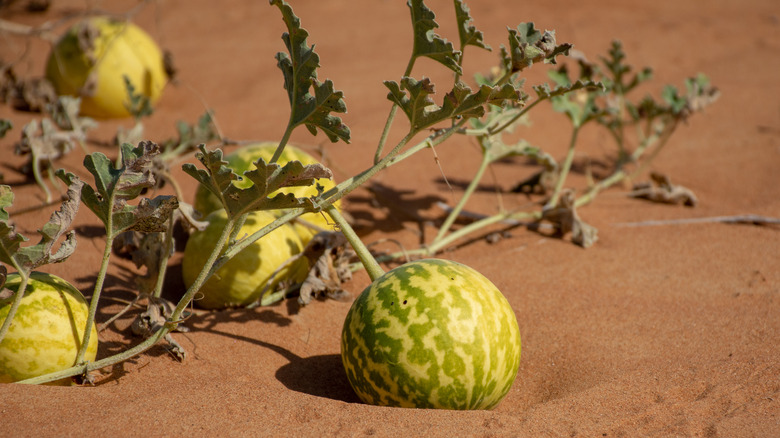Why Watermelon's Latin Name May Be Incorrect
Humans have sliced into the succulent flesh of watermelons for thousands of years. From depictions in Egyptian tombs, a citing by Pliny the Elder, and a patch in Thomas Jefferson's garden, the beloved fruit frequently appears throughout history, via the University of Missouri.
With its sweet, hydrating flesh, and large size that seems built for sharing, it's easy to comprehend the fruit's popularity. And likely due to its immediately rejuvenating properties, watermelons have long been associated with medicinal properties. In Russia, several sanatoriums treat sickly with a watermelon diet, per The New York Times, while in China, the fruit is used in healing, reduce restlessness, and cool the body, states Restore Health and Wellness. And while its true health effects are not entirely proven, it does contain antioxidants like lycopene which can help reduce blood pressure, according to Healthline. Yet despite its cultural pervasion and global ubiquity, the fruit's Latin name may be referring to a different fruit altogether. So let's peer underneath the rind to understand its backstory.
Watermelon's name Citrullus lanatus refers to a bitter, hairy sister species
The large fruit's naming confusion stems from its uncertain origins. Consumption of proto-watermelon started 5,000 years ago, back when the fruit was bitter and white. A rare vehicle for water in the desert, generations of breeding transformed the fruit into what we know today. Exactly how or when this occurred is unknown. There are several distinct species of desert melon grown across South, West, and Northeastern Africa. Horticulturist Harry Paris told National Geographic that it was in Ancient Egypt when the red flesh took hold.
Since it's debated which of the desert melons became the watermelon, their classification is tricky. In 1773, a pupil of Linnaeus deemed watermelon Citrullus lanatus, its current Latin name, as part of a family including squash, cucumbers, and zucchini. The leaves he used for reference belonged to a citron, an unrelated species with a hairy exterior and bitter interior, per New Phytologist Foundation.
The mistake was recognized, but the name for watermelon stuck. Now, lanatus refers generally to the species formally called dessert watermelon and to the specific subspecies of citron that was originally misnamed. Genetic analysis has shown that while both come from the African desert, these various species couldn't be more different, necessitating a taxonomical revamp, states Annals of Botany. For now, we'll leave the naming up to biologists and turn attention to the stem for searching for the ripest one at the grocery store.

